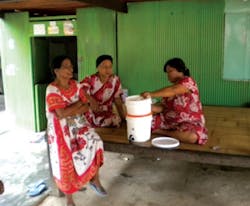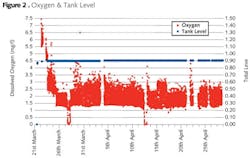Pipe Dreams in Poland
Trenchless rehabilitation methods may have been used in Poland for over two decades, but such techniques are still proving popular. As joint host of the Euro 2012 with Ukraine, Poland is on a mission to bring its infrastructure up to date. An overview of several projects, including a wastewater facility connection.
Trenchless installation technologies have been in use in Poland since the beginning of the 1990s. This was as a result of a transportation boom and need to tunnel beneath roads and railways, or in congested areas to avoid disruption and damage caused by excavation. The development of remote controlled drilling equipment and introduction of hydraulic excavation led to these "no-dig" techniques becoming popular.
Intermediate jacking station in a GRP line
Today, a great range of no-dig options are employed for establishing or rehabilitating almost all underground infrastructure. This includes sewers, water mains, gas, energy and communications lines, tunnels and underpasses, road and railway drainage and hydro-technical culvert.
Poland invests heavily in trenchless research and relies on its numerous technical institutions, colleges and laboratories whose results are promptly put into practice. Such research has led to Centrifugally Cast Glass Fiber Reinforced Plastics (CC-GRP) pipes, reinforced concrete as well as polymer-concrete and stoneware pipes being commonly used for micro-tunneling in Poland.
In Poland the static-strength calculations for pipes installed by micro-tunneling are usually affected by the ATV-A 161 guidelines. These guidelines help determine the minimum thickness of the pipe wall for the designed length of drive. These calculations include the defined safety coefficients for the material parameters and the designated installation technology.
Such a method is commonly applied and forms the basis for calculating micro-tunneling ducts, irrespective of the used material.
In the case of CC-GRP pipes, the compressive strength characteristically amounts to 90 MPa. Due to a wide range of wall thicknesses (up to 12 kinds for each diameter), calculations allow a choice of thickness to help constitute the most economically justified solution.
CC-GRP - Centrifugally Cast Glass Fiber Reinforced PlasticsCC-GRP is particularly favored in Poland for various reasons. The material's high compressive strength (90 MPa) results in comparably small wall thicknesses and therefore also smaller exterior diameters at required interior diameter. Lower jacking forces are thus necessary and costs regarding the installation process as well as hoisting equipment and thrust pits are reduced. Less excavation material leads to less transportation costs and less emissions.
Thanks to the material's high resilience (a relatively low Young module at high compressive strength) it is not necessary to use wooden separators (rectilinear micro-tunneling) in bends of angle joints connected with the pipe control. Apart from the previously mentioned characteristic compressive strength, the material is characterized by a relatively high longitudinal strain (0.7%). Tests conducted over a span of 25 years at the universities in Bochum and Dortmund in Germany and Illinois in the U.S. confirm these properties. In practice, numerous contractors have experienced an array of successful CC-GRP installations by micro-tunneling on straight as well as curved routes.
Micro-tunneling - first steps in Poland
The first micro-tunneling project to break ground for trenchless GRP pipes in Poland was executed in Torun between 1997 to 1998. After the successful installation of this 973m long collector measuring a diameter of DN1600, glass fiber composites became more and more widely applied for micro-tunneling across the entire country.
Impressive jobs such as the Sleza collector in Wrocław or the collector under Prymasa Tysiaclecia Street in Warsaw followed soon after. The latter, implemented between 2001 to 2003, was at the time the largest jacking project in Europe and represented a technical milestone.
The works were conducted at a depth of between nine to 11 meters in water carrying sand and clay, which were difficult to separate from the drilling fluid. The 6km long pipeline route was divided into five sections and the longest (470m) was executed with three intermediate jacking stations.
Bentonite lubricant was injected in all sections to reduce friction between pipe and soil, keeping the necessary jacking forces beneath 6500kN.
Despite challenging conditions the DN 2400 CC-GRP pipeline possessing a nominal stiffness of 32000 N/m2 and a 76mm thick wall could be jacked with extraordinary precision, deviating less than 1cm.
Pipe dreams in Warsaw
An even greater challenge was faced and mastered on a technical level during a further project that started in Warsaw in 2009. This saw a CC-GRP collector measuring 3000mm in exterior diameter jacked to connect the west of Warsaw to the wastewater treatment plant "Czajka". As part of the project, over seven kilometres of pipes were jacked on two sections.
It is worthwhile highlighting the 840m long part of the first section where the pipes were supposed to be jacked from both ends and meet in the middle. Instead, the installation was made so precisely that the section was jacked with one single drive and from one side only.
In the second stage of the project, pipes were jacked beneath the main road of the district Bialoleka. An open trench would not have been possible here since the construction works would have impaired the traffic on the three lane road. A single drive over 910m broke the record of the longest single drives in the project.
Rehabilitation
Trenchless rehabilitation methods further developed in parallel to jacking and boring installations across Poland. They are commonly applied for underground networks in cities – particularly those which are difficult to access. In general these technologies can be roughly divided into several groups:
- Fold and Form Pipe (FFP) – or close-fit renewal
- CIPP - Cured in Place Pipe (CIPP) renewal
- Insitu applied coatings – these do not lend structural strength to the renovated line but serve to increase durability and lend tightness.
- Sectional sliplining with adapted profiles
In Poland GRP is commonly used also for these installations, especially for renewing large diameter conduits. The first large diameter project was a 3km long collector with a diameter of 1600mm, including GRP profiles. This was reconstructed in Wrocław in 1999. The success of this undertaking triggered further rehabilitation projects across various Polish cities.
Infrastructural plan
As a result of a major transport construction and modernisation programme, launched before the turn of the century, almost all newly installed or rehabilitated underground structure is implemented with trenchless techniques. Following this, an updated programme was handed out by the Decree of the Council of Ministers in May 2004.
Part of the plans from the government include an extension of the national motorway network from 850 to 2000km. To date over 812km were completed by the end of August 2009 and another 337km are under construction. Furthermore, 1633km of motorway are planned to be finalised and opened for the European Football Championship in 2012. This includes the whole southern A4 motorway, the A1 and the A2 section between the German border and Warsaw.
Developments, however, also concern the extension of the 560km express road network to 5300km. There are presently about 600km of express roads and city ring roads at different construction stages. Bound to international agreements, the situation for railway lines is similar. These are successively modernised to ensure their compliance with the trans-European conventional rail system in the trans-European high-speed rail system.
The program for establishing high-speed lines by 2030 was developed in Poland in 2005. This involves the construction of a new line from Warsaw via Łódz with branch connections to Wrocław and Poznan incorporating the already existing CMK (Central Main Railway).
The tracks are designed to allow speeds up to 250 km/h. A new line from Cracow to the area of Tymbark is erected simultaneously, incorporating the south-east of Poland in the national network of high-speed rail connections.
Author's note: This article was based on the report: 'Developing the transport infrastructure in Poland with Trenchless Technology and GRP Pipe Systems'. This report was co-authored by Professor Adam Wysokowski (Road and Bridges Department, University of Zielona Góra, Poland) Professor Cezary Madryas (vice rector and head of the municipal engineering department, Wrocław University of Technology, Poland) and Lech Skomorowski (managing director of HOBAS Poland). For further information, please email: [email protected]
More Water & WasteWater International Current Issue Articles
More Water & WasteWater International Archives Issue Articles


